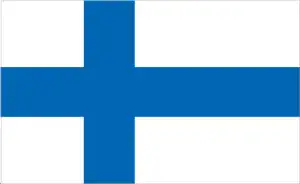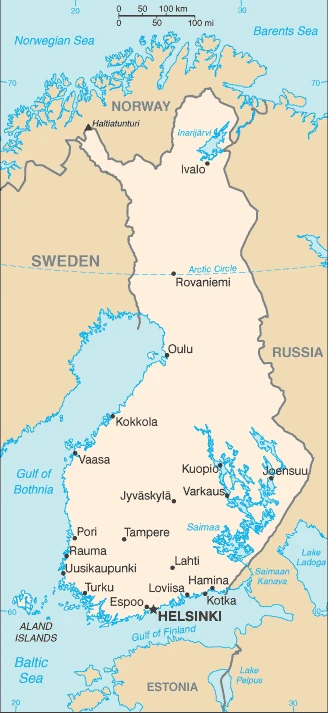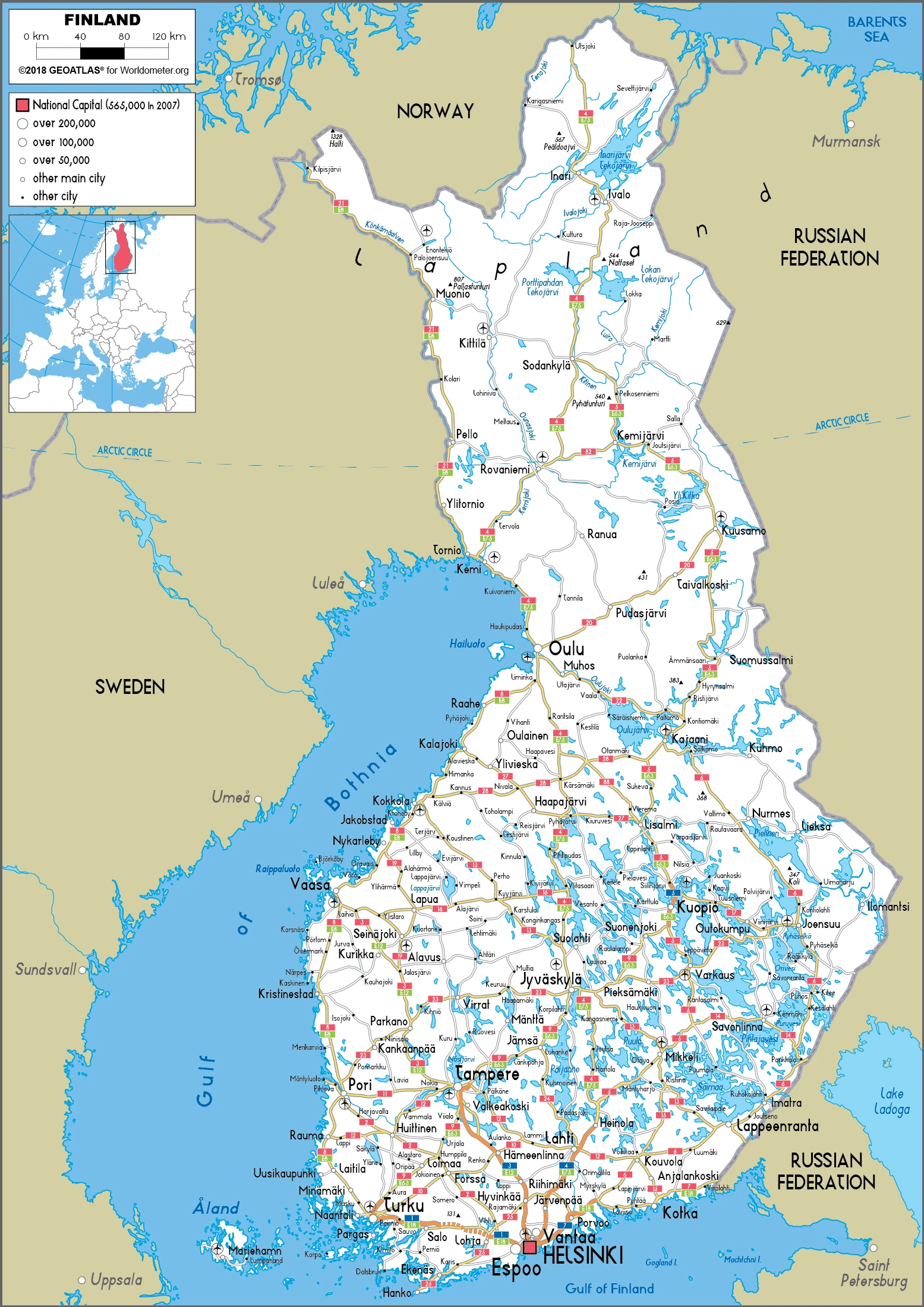Finland Google Maps is a site/tool that offers a wide range of map views (topographic, satellite, street view) and navigation options, with little effort on your part, yet efficiently. If you need to plan a trip to a new place like Finland, Google maps are available on desktop, mobile, or tablet. This Google maps and information page is dedicated to Finland, Europe (47 countries), showing its location, country facts, details about its capital city Helsinki, bordering countries like Norway, Sweden, Russia, and plenty of other information which may be interesting when you visit this European state.
Quick links: Google Maps Finland, Helsinki Google maps, Driving Directions Finland, Printable Road Map.

About Finland in a nutshell
- Conventional short form of the name: Finland
- The conventional long form of the name: Republic of Finland
- Local long form: Suomen tasavalta / Republiken Finland
- Local short form: Suomi / Finland
- Former name(s): N/A
- Etymology: name may derive from the ancient Fenni peoples who are first described as living in northeastern Europe in the first centuries A.D..
- The legal system in Finland: civil law system based on the Swedish model.
- Climate: Long, harsh winters with frequent snowfalls. Short, warmer summers. Rainfall is low, and decreases northward.
- The national symbols are lion; national colors: blue, white.
- Internet TLD: .fi
Occupying the center of Europe’s only primeval heartland, Finland is spread over two large landscapes: north of the Arctic Circle, Lapland is the treeless tundra of reindeer-herding nomadic Sámi Lapland, while to the south, the Lake Finland region of tens of thousands of lakes in the realm of pine forests, the taiga.
The map’s green is deceptive: on the glaciated surface, which looks like a plain, the former boundaries of the glaciers are marked by 100-200 m high ridge-like ridges and moraine deposits of glacial debris. In the north, barren mountain tops, the tundra serves as an excellent skiing area in winter, and in the south, forested ridges and dunes rise. There are many carved rocks and peregrine stones – nature has carved a genuinely varied landscape into the ancient rocks. The northernmost country in Europe, furthest from the ocean, has a harsher and more extreme climate than its counterparts at the same latitude.
Winters are colder, lakes are covered in thick ice, and the two large bays of the Baltic Sea, the Gulf of Bothnia and the Gulf of Finland, freeze over in winter.
In Finland, which is rich in natural formations, only the Kvarken archipelago, the High Coast of Finland, has been inscribed on the World Natural Heritage List. The more than 30 fish graves in the Bronze Age cemetery at Sammallahdenmaki, the oldest Finnish harbor on the Gulf of Bothnia, the old town of Rauma, the 18th-century church of Petajave-si on Lake Finns, the 18th-century fortress of Suomenlinna in the port of Helsinki, the late 19th-century wood processing plant at Verla and the foundations of the Struve surveying network in Finland are all universal treasures of humanity.
Finland has Europe’s most extensive inland waterway system.
Background
Finland was a province and then a grand duchy under Sweden from the 12th to the 19th centuries and an autonomous grand duchy of Russia after 1809. It gained complete independence in 1917. During World War II, Finland successfully defended its independence through cooperation with Germany and resisted subsequent invasions by the Soviet Union – albeit with some loss of territory. In the subsequent half-century, Finland transformed from a farm/forest economy to a diversified modern industrial economy. Per capita income is among the highest in Western Europe. A member of the EU since 1995, Finland was the only Nordic state to join the euro single currency at its initiation in January 1999. In the 21st century, the key features of Finland’s modern welfare state are high-quality education, promotion of equality, and a national social welfare system – currently challenged by an aging population and the fluctuations of an export-driven economy.
Geography
South and center are flat, with low hills and many lakes. Uplands and low mountains in the north. 60% of the land area is forested.

Its Scandinavian and Russian neighbors have influenced Finlands language and national identity. Once aligned with the USSR, Finland is now a member of the EU.
This state is located in Northern Europe, bordering the Baltic Sea, Gulf of Bothnia, and the Gulf of Finland, between Sweden and Russia, under the coordinates of 64 00 N, 26 00 E, covering an area of 338,145 sq km with a coastline of 1,250 km. Finland is Slightly more than two times the size of Georgia, slightly smaller than Montana.
Finland has 2,563 km of land boundaries in total and borders with (3 nations): Norway 709 km, Sweden 545 km, Russia 1309 km.
Mostly low, flat to rolling plains interspersed with lakes and low hills, with Halti (alternatively Haltia, Haltitunturi, Haltiatunturi) 1,328 m as the highest point of Finland, while Baltic Sea 0 m as the lowest point, causing a mean elevation at 164 m throughout the country. With a total of 338,145 sq km, Finland has 303,815 sq km of land and 34,330 sq km water surface area.
Major water bodies in the country: Saimaa – 1,760 sq km; Paijanne – 1,090 sq km; Inarijarvi – 1,000 sq km; Oulujarvi – 900 sq km; Pielinen – 850 sq km (freshwater lake), none of saltwater lake, while the major rivers are: none.
The extended boundary with Russia; Helsinki is the northernmost European continent; the population is concentrated on the small southwestern coastal plain.
The climate in Finland is as follows: Cold temperate, potentially subarctic but comparatively mild because of moderating influence of the North Atlantic current, baltic sea, and more than 60,000 lakes.
When you visit Finland, the natural hazards shall be considered: Severe winters in the north.
The following major health-threatening issues shall be considered when visiting Finland: none.
Current environmental issues affecting the Finnish people: limited air pollution in urban centers; some water pollution from industrial wastes, agricultural chemicals; habitat loss threatens wildlife populations.
Google Maps Finland
The capital and other divisions
Capital city: Helsinki found under the coordinates 60 10 N, 24 56 E, applying the time zone UTC+2 (7 hours ahead of Washington, DC, during Standard Time), using the following daylight saving time: +1hr begins last Sunday in March; ends last Sunday in October.
Helsinki is the capital of Finland and a popular destination for tourists. The city mixes old-world charm with modernity, making it one of Europes best cities to visit.
Finland became independent on December 6th, 1917 (from Russia), and its national holiday is Independence Day, December 6th (1917).
Administrative divisions: 19 regions (maakunnat, singular – maakunta (Finnish); landskapen, singular – landskapet (Swedish)); Aland (Swedish), Ahvenanmaa (Finnish); Etela-Karjala (Finnish), Sodra Karelen (Swedish) South Karelia; Etela-Pohjanmaa (Finnish), Sodra Osterbotten (Swedish) South Ostrobothnia; Etela-Savo (Finnish), Sodra Savolax (Swedish) South Savo; Kanta-Hame (Finnish), Egentliga Tavastland (Swedish); Kainuu (Finnish), Kajanaland (Swedish); Keski-Pohjanmaa (Finnish), Mellersta Osterbotten (Swedish) Central Ostrobothnia; Keski-Suomi (Finnish), Mellersta Finland (Swedish) Central Finland; Kymenlaakso (Finnish), Kymmenedalen (Swedish); Lappi (Finnish), Lappland (Swedish); Paijat-Hame (Finnish), Paijanne-Tavastland (Swedish); Pirkanmaa (Finnish), Birkaland (Swedish) Tampere; Pohjanmaa (Finnish), Osterbotten (Swedish) Ostrobothnia; Pohjois-Karjala (Finnish), Norra Karelen (Swedish) North Karelia; Pohjois-Pohjanmaa (Finnish), Norra Osterbotten (Swedish) North Ostrobothnia; Pohjois-Savo (Finnish), Norra Savolax (Swedish) North Savo; Satakunta (Finnish and Swedish); Uusimaa (Finnish), Nyland (Swedish) Newland; Varsinais-Suomi (Finnish), Egentliga Finland (Swedish) Southwest Finland.
People and society
One in four of the population lives in the Greater Helsinki region. Swedish speakers live mainly in the Islands in the southwest. The Sámi (Lapps) lead a seminomadic existence inside the Arctic Circle. Women make up 48% of the labor force, continuing a long tradition of equality between the sexes. Finnish women were the first in Europe to vote in 1906 and the first to stand for parliament globally. Families tend to be close-knit.
The population in Finland is 5,587,442 (July 2021 estimate), with an average of 0.26% (2021 estimate) change. That means Finland is the No. 115 in the world’s populated rank list. With an average of 42.8 years median age (41.3 years for males and 41.3 years for women), Finland ranks No. 31 on the globe’s median age rank list.
The people living in this country are the Finn(s) (noun) or Finnish (adjective) and belong mainly to the following ethnic groups: Finn, Swede, Russian, Estonian, Romani, Sami.
They speak Finnish (official language) 86.9%, Swedish (official language) 5.2%, Russian 1.5%, other 6.4% (2020 estimate) languages and practice the following religions: Lutheran 67.8%, Greek Orthodox 1.1%, other 1.7%, unspecified 29.4% (2020 estimate).
We can conclude the following about the population in Finland: The vast majority of people are found in the south. The northern interior areas remain sparsely populated. In Finland, we are talking about 85.6% (2021) of the total population is living in cities, and most of them reside in the following municipalities: 1.317 million, Helsinki (capital city) (2021).
Industry
Strong engineering and electronics sectors: home of Nokia. Wood, pulp, and paper production.
Finland has a highly industrialized, largely free-market economy with a per capita GDP almost as high as Austria and the Netherlands and slightly above Germany and Belgium. Trade is significant, with exports accounting for over one-third of GDP in recent years. The government is open to and actively attracting foreign direct investment. Finland is historically competitive in manufacturing, particularly in the wood, metals, engineering, telecommunications, and electronics industries.
Finland excels in exporting technology and promoting startups in the information and communications technology, gaming, cleantech, and biotechnology sectors. Except for timber and several minerals, Finland depends on importing raw materials, energy, and some components for manufactured goods. Because of the cold climate, agricultural development is limited to maintaining self-sufficiency in primary products. Forestry, an important export industry, provides a secondary occupation for the rural population. Finland had been one of the best-performing economies within the EU before 2009, and its banks and financial markets avoided the worst of the global financial crisis. However, the world slowdown hit exports and domestic demand hard in that year, causing Finland’s economy to contract from 2012 to 2014. The recession affected general government finances and the debt ratio.
The economy returned to growth in 2016, posting a 1.9% GDP increase before growing an estimated 3.3% in 2017, supported by a substantial increase in investment, private consumption, and net exports. Finnish economists expect GDP to grow by 2-3% in the next few years. Finland’s main challenges will be reducing high labor costs and boosting export demand. In June 2016, the government enacted a Competitiveness Pact to reduce labor costs, increase hours worked, and introduce more flexibility into the wage bargaining system. As a result, wage growth was nearly flat in 2017. The government also sought to reform the health care system and social services. Finland must address a rapidly aging population and decreasing productivity in traditional industries that threaten competitiveness, fiscal sustainability, and economic growth in the long term.
Finland is rich in the following natural resources: Timber, iron ore, copper, lead, zinc, chromite, nickel, gold, silver, limestone.
The main industrial sectors are typically metals and metal products, electronics, machinery and scientific instruments, shipbuilding, pulp and paper, foodstuffs, chemicals, textiles, clothing.
The country’s export sectors are robust in refined petroleum, paper and wood pulp products, cars, stainless steel, lumber (2019), partnering with these nations: Germany 14%, Sweden 10%, United States 8%, Netherlands 6%, China 6%, Russia 5% (2019). The export trade resulted in $108.22 billion. Note: Data are in current year dollars (2019 estimate). In a global rank of the export, values resulted in Finland’s position of 39.
Land use in Finland: 72.9% (2018 estimate) forest, 19.6% (2018 estimate) other.
The arable land area is 7.4% (2018 estimate), and the agricultural land is 7.5% (2018 estimate). Land use for permanent crops 0% (2018 estimate), permanent pasture 0.1% (2018 estimate). The sum of the area of the irrigated land is 690 sq km (2012).
The main agro-industrial products of Finland are milk, barley, oats, wheat, potatoes, sugar beet, rye, pork, poultry, beef.
The country typically needs to import: crude petroleum, cars and vehicle parts, refined petroleum, broadcasting equipment, packaged medicines (2019), partnering with the following nations: Germany 16%, Sweden 14%, Russia 13%, China 6%, Netherlands 6% (2019) in a sum value of $107.39 billion. Note: data are in current year dollars (2019 estimate) $109.45 billion. Note: data are in current year dollars (2018 estimate) $110.701 billion (2017 estimate). This sum value on the global ranking list of imports resulted in Finland 38.
Finland Driving Directions
In this post, you learned about Finland, Northern Europe, bordering the Baltic Sea, Gulf of Bothnia, and Finland, between Sweden and Russia. We published some basic information about its capital Helsinki, and the Finnish nation.
Are you interested in visiting Finland and looking for driving directions? Click here to plan your route, or see a printable road map of Finland below for an overview of the route network.
Printable map of Finland
Did you know about Finland?
Finland has lots of lakes and rivers that produce more electricity than it consumes.
Finland is one of the only countries globally that has been officially recognized as a nation-state from the moment it was established. On December 6th, 1917, Finland’s parliament declared that Finland was an independent country and had no obligations to any other state. Since then, Finland has been granted full membership in the United Nations and the Council of Europe.
After virtually visiting Finland, you may also be interested in the neighboring countries: Estonia, Norway, Sweden, Russia.
If you liked our Google map and Finland information page,
please share it with others or save the link https://www.drivingdirections.net in your bookmarks.

